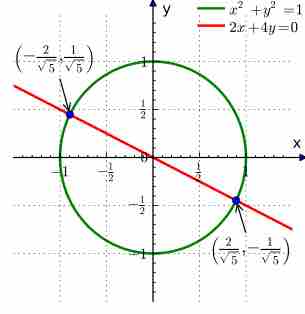A system of equations (also known as simultaneous equations) is a set of equations with multiple variables, solved when the values of all variables simultaneously satisfy all of the equations. The most common ways to solve a system of equations are:
Here, we will address the graphical method.
Solving Systems Graphically
Some systems have only one set of correct answers, while others have multiple sets that will satisfy all equations. Shown graphically, a set of equations solved with only one set of answers will have only have one point of intersection, as shown below. This point is considered to be the solution of the system of equations. In a set of linear equations (such as in the image below), there is only one solution.

System of linear equations with two variables
This graph shows a system of equations with two variables and only one set of answers that satisfies both equations.
A system with two sets of answers that will satisfy both equations has two points of intersection (thus, two solutions of the system), as shown in the image below.

System of equations with multiple answers
This is an example of a system of equations shown graphically that has two sets of answers that will satisfy both equations in the system.
Converting to Slope-Intercept Form
Before successfully solving a system graphically, one must understand how to graph equations written in standard form, or
To do this, you need to convert the equations to slope-intercept form, or
The best way to convert an equation to slope-intercept form is to first isolate the y variable and then divide the right side by B, as shown below.
Now
Identifying Solutions on a Graph
Once you have converted the equations into slope-intercept form, you can graph the equations. To determine the solutions of the set of equations, identify the points of intersection between the graphed equations. The ordered pair that represents the intersection(s) represents the solution(s) to the system of equations.